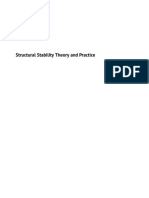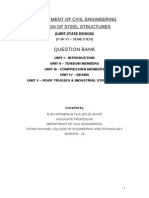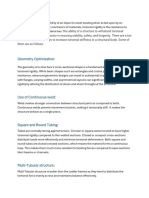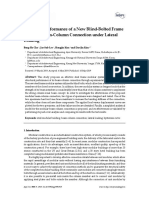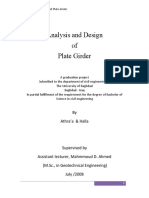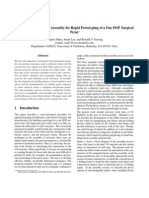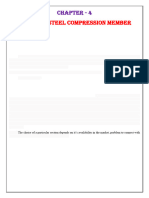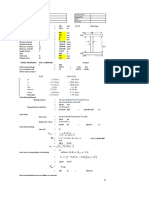Cold Formed Steel Design
Cold Formed Steel Design
Uploaded by
MCopyright:
Available Formats
Cold Formed Steel Design
Cold Formed Steel Design
Uploaded by
MCopyright
Available Formats
Share this document
Did you find this document useful?
Is this content inappropriate?
Copyright:
Available Formats
Cold Formed Steel Design
Cold Formed Steel Design
Uploaded by
MCopyright:
Available Formats
COLD FORMED STEEL DESIGN In steel construction, there are two main families of Structural members.
One is the familiar group of hot-rolled shapes and members built up of plates. The other, less familiar but of growing importance, is composed of sections cold formed from steel sheet, strip, plate, or flat bar in roll-forming machines or by press brake or bending brake operations. These are cold-formed steel structural members. The thickness of steel sheet or strip generally used in cold-formed steel structural members ranges from 0.378 mm to about 6.35 mm. Steel plates and bars as thick as 25.4 mm can be cold formed successfully into structural shapes. Although cold-formed steel sections are used in car bodies, railway coaches, various types of equipment, storage racks, grain bins, highway products, transmission towers, transmission poles, drainage facilities, and bridge construction, the discussions included herein are primarily limited to applications in building construction. For structures other than buildings, allowances for dynamic effects, fatigue, and corrosion may be necessary. In general, cold-formed steel structural members provide the following advantages in building construction: 1. As compared with thicker hot-rolled shapes, cold formed light members can be manufactured for relatively light loads and/or short spans. 2. Unusual sectional configurations can be produced economically by coldforming operations and consequently favorable strength-to-weight ratios can be obtained. 3. Nestable sections can be produced, allowing for compact packaging and shipping. 4. Load-carrying panels and decks can provide useful surfaces for floor, roof, and wall construction, and in other cases they can also provide enclosed cells for electrical and other conduits. 5. Load-carrying panels and decks not only withstand loads normal to their surfaces, but they can also act as shear diaphragms to resist force in their own planes if they are adequately interconnected to each other and to supporting members. Compared with other materials such as timber and concrete, the following qualities can be realized for cold formed steel structural members 1. Lightness 2. High strength and stiffness 3. Ease of prefabrication and mass production 4. Fast and easy erection and installation 5. Substantial elimination of delays due to weather 6. More accurate detailing 7. Nonshrinking and noncreeping at ambient temperatures 8. Formwork unneeded 9. Termite proof and rot proof 10. Uniform quality 11. Economy in transportation and handling Manjunath V Bhogone, Assistant Professor, Civil Engineering Department Sinhgad College of Engineering, Pune 41
January 31, 2012
12. Noncombustibility 13. Recyclable material The combination of the above-mentioned advantages can result in cost saving in construction. TYPES OF COLD-FORMED STEEL SECTIONS AND THEIR APPLICATIONS Cold-formed steel structural members can be classified into two major types: 1. Individual structural framing members 2. Panels and decks
Figure 1: Cold-formed sections used in structural framing. 1. Individual Structural Framing Members Figure 1 shows some of the cold-formed sections generally used in structural framing. The usual shapes are channels (C-sections), Z-sections, angles, hat sections, I-sections, T-sections, and tubular members. 2 Panels and Decks Another category of cold-formed sections is shown in Fig. 2. These sections are generally used for roof decks, floor decks, wall panels, siding material, and bridge forms. Some deeper panels and decks are cold formed with web stiffeners. The depth of panels generally ranges from 38.1 to 191 mm, and the thickness of materials ranges from 0.457 to 1.91 mm.
Manjunath V Bhogone, Assistant Professor, Civil Engineering Department Sinhgad College of Engineering, Pune 41
January 31, 2012
Figure 2: Decks, panels, and corrugated sheets. Stiffened and unstiffened elements If a plate's edges are restrained against buckling, then the force required to buckle the plate increases. If one edge is restrained (i.e. and "unstiffened" plate element) the force to cause out-of-plane buckling is less than that required to buckle a plate with two edges restrained against out-of-plane buckling. An intersecting plate at a plate edge adds a significant moment of inertia out of plane to the edge which prevents deflection at the attached edge. Figure 3 illustrates the modes of buckling for a stiffened and unstiffened plate element.
Figure 3: Plate buckling modes Manjunath V Bhogone, Assistant Professor, Civil Engineering Department Sinhgad College of Engineering, Pune 41
January 31, 2012
Figure 4: Unstiffened element Multiple stiffened elements A multiple-stiffened element is an element that is stiffened between webs, or between a web and a stiffened edge, by means of intermediate stiffeners which are parallel to the direction of stress (Figure 5).
Figure 5: Multiple stiffened compression element Flat width ratio, w The flat width w used in the design of cold-formed steel structural members is the width of the straight portion of the element and does not include the bent portion of the section. For unstiffened flanges, the flat width w is the width of the flat projection of the flange measured from the end of the bend adjacent to the web to the free edge of the flange, as shown in Fig. 6a. As shown in Fig. 6b, for a built-up section the flat width of the unstiffened compression element is the portion between the centre of the connection and the free edge. The flat width w of a stiffened element is the width between the adjacent stiffening means exclusive of bends, as shown in Fig. 7a. For the composite section shown in Fig. 7b, the flat width of the stiffened compression flange is the distance between the centres of connections.
Manjunath V Bhogone, Assistant Professor, Civil Engineering Department Sinhgad College of Engineering, Pune 41
January 31, 2012
Figure 6: Flat width of unstiffened compression elements
Figure 7: Flat width of stiffened compression elements Effective Design Width, b The effective design width b is a reduced design width for computing sectional properties of flexural and compression members when the flat widththickness ratio of an element exceeds a certain limit. Figure 8 shows effective design widths of flexural and comparison members.
Manjunath V Bhogone, Assistant Professor, Civil Engineering Department Sinhgad College of Engineering, Pune 41
January 31, 2012
Manjunath V Bhogone, Assistant Professor, Civil Engineering Department Sinhgad College of Engineering, Pune 41
January 31, 2012
Manjunath V Bhogone, Assistant Professor, Civil Engineering Department Sinhgad College of Engineering, Pune 41
January 31, 2012
Figure 8: Effective design width of flexural and compression members Sectional properties The properties of sections (cross-sectional area, moment of inertia, section modulus and radius of gyration) shall be determined in accordance with the conventional methods of structural design. Computation of properties of formed sections may be simplified by using a method called linear method in which the material of the section is considered concentrated along the central line of the steel sheet and the area elements replaced by straight or curved line elements. The thickness element t is introduced after the linear computation has been completed. The total area of the section is found from the relation Area = L x t' where L is the total length of all the elements. The moment of inertia of the section is found from the relation I = I^ x t where I^ is the moment of inertia of the central line of steel sheet. The section modulus is computed as usual by dividing I or (I^ x t ) by the distance from neutral axis to the extreme and not to the central line of extreme element. First power dimensions such as x, y and Y ( radius of gyration ) are obtained directly by the linear method and do not involve the thickness dimension. When the flat width w of a stiffened compression element is reduced for design purposes, the effective design width b is used directly to compute the total effective length Leffective of the line elements. The elements into which most sections may be divided for application of the linear method consist of straight lines and circular arcs. For convenient reference, the moments of inertia and location of centroid of such elements are identified in Fig. 9. The formula for line elements are exact, since the line as such has no thickness dimensions; but in computing the properties of an actual section, where the line element represents an actual element with a thickness dimension, the results will be approximate for the following reasons: a) The moment of inertia of a straight actual element about its longitudinal axis is considered negligible. b) The moment of inertia of a straight (actual) element inclined o the axis of reference is slightly larger than that of the corresponding line element, but for elements of similar length the error involved is even less than the error involved in neglecting the moment of inertia of the element about its longitudinal axis. Obviously, the error disappears when the element is normal to the axis. Small errors are involved in using the properties of a linear arc to find those of an actual corner, but with- the usual small corner radii the error in the location of the centroid of the corner is of little importance and the moment of inertia generally negligible. When the mean radius of a circular element is over four times its thickness, as for tubular sections and for sheets with circular corrugations, the error in using linear arc properties practically disappears.
Figure 9: Properties of line elements (continued)
Manjunath V Bhogone, Assistant Professor, Civil Engineering Department Sinhgad College of Engineering, Pune 41
January 31, 2012
Figure 9: Properties of line elements
Manjunath V Bhogone, Assistant Professor, Civil Engineering Department Sinhgad College of Engineering, Pune 41
January 31, 2012
You might also like
- (GEOSS) - Guidelines On Good Practices For Pile Load TestDocument10 pages(GEOSS) - Guidelines On Good Practices For Pile Load TestPeter KyawNo ratings yet
- Sukhvarsh Jerath - Structural Stability Theory and Practice - Buckling of Columns, Beams, Plates, and Shells (2021, Wiley) - Libgen - LiDocument654 pagesSukhvarsh Jerath - Structural Stability Theory and Practice - Buckling of Columns, Beams, Plates, and Shells (2021, Wiley) - Libgen - LiIgor100% (1)
- CE 511 Simulation 3.1Document2 pagesCE 511 Simulation 3.1Daniel DomingoNo ratings yet
- The Mechanics of WrinklesDocument13 pagesThe Mechanics of Wrinklessuprat tikno0% (1)
- Reinforced Concrete Buildings: Behavior and DesignFrom EverandReinforced Concrete Buildings: Behavior and DesignRating: 5 out of 5 stars5/5 (1)
- Dimensions, Weights and Properties of Special and Standard Structural Steel Shapes Manufactured by Bethlehem Steel CompanyFrom EverandDimensions, Weights and Properties of Special and Standard Structural Steel Shapes Manufactured by Bethlehem Steel CompanyNo ratings yet
- Design and Calculation of A Wind Turbine of 250 KW in Hvaler Norway PDFDocument218 pagesDesign and Calculation of A Wind Turbine of 250 KW in Hvaler Norway PDFBayari Ar50% (2)
- Chapter Two, Tension Members PDFDocument10 pagesChapter Two, Tension Members PDFZeleke TaimuNo ratings yet
- Unit 1Document30 pagesUnit 1balachandran143No ratings yet
- Unit 1 PDFDocument30 pagesUnit 1 PDFpankajNo ratings yet
- 3 D Finite Element Analysis of Partially Restrained Beam To Column Connections in Steel Frames PDFDocument5 pages3 D Finite Element Analysis of Partially Restrained Beam To Column Connections in Steel Frames PDFGC UniversNo ratings yet
- Study On Behaviour of Stud Type Shear Connector in Composite Beam Using ANSYSDocument5 pagesStudy On Behaviour of Stud Type Shear Connector in Composite Beam Using ANSYSShubham BajpaiNo ratings yet
- Numerical Estimation and Analysis of Effective Width of Composite Beams With Ribbed SlabDocument15 pagesNumerical Estimation and Analysis of Effective Width of Composite Beams With Ribbed SlabInternational Journal of Application or Innovation in Engineering & ManagementNo ratings yet
- Composite Structures Full Notes Part 3 PDFDocument23 pagesComposite Structures Full Notes Part 3 PDFsvnNo ratings yet
- Design Considerations of CastingsDocument8 pagesDesign Considerations of Castingshaqjmi100% (2)
- Design of Steel Structures BS 5950: Eng. Chamara Yapa Arachchi Civil EngineerDocument60 pagesDesign of Steel Structures BS 5950: Eng. Chamara Yapa Arachchi Civil Engineerpareen9No ratings yet
- CE2352 DSS 2 Marks With AnswerDocument33 pagesCE2352 DSS 2 Marks With Answerkavithamartin28No ratings yet
- ZK0601249255 PDFDocument7 pagesZK0601249255 PDFAJER JOURNALNo ratings yet
- ChapDocument49 pagesChapAhmed AlrashidNo ratings yet
- Mahalakshmi: Engineering CollegeDocument30 pagesMahalakshmi: Engineering CollegeSawan HussainNo ratings yet
- EC4 DesignOfCompositeColumns PDFDocument27 pagesEC4 DesignOfCompositeColumns PDFtoliveira80100% (1)
- Composite Beam DesignDocument42 pagesComposite Beam Designbsitler100% (1)
- Structure Base JCSRDocument46 pagesStructure Base JCSRivan bolañosNo ratings yet
- Unit 3Document29 pagesUnit 3ashok Pradhan100% (1)
- CYPE CONNECT-Calculations Report PDFDocument16 pagesCYPE CONNECT-Calculations Report PDFAHMAD BALFAQIHNo ratings yet
- Ce1302 Design of RC ElementsDocument22 pagesCe1302 Design of RC Elementsjs kalyana rama100% (1)
- 01 Prajwal JiwtodeDocument20 pages01 Prajwal Jiwtode01 - Prajwal JiwtodeNo ratings yet
- Analysis of RCC Beams Using ABACUSDocument8 pagesAnalysis of RCC Beams Using ABACUSvijjikewlguy7116No ratings yet
- Composite Deck DesignDocument16 pagesComposite Deck Designvejanidb100% (1)
- Roof Truss Design For Industrial BuildingsDocument10 pagesRoof Truss Design For Industrial Buildingsalluru anuradhaNo ratings yet
- Question Bank: Department of Civil Engineering Design of Steel StructuresDocument61 pagesQuestion Bank: Department of Civil Engineering Design of Steel Structuresbrownpepper30No ratings yet
- Question 2Document5 pagesQuestion 2Asif MorshedNo ratings yet
- Composite Deck DesignDocument16 pagesComposite Deck DesignAhmad FitrahNo ratings yet
- Study of Rigid Bolt Joint in Beam-Column Connection of Gabled Portal FramesDocument6 pagesStudy of Rigid Bolt Joint in Beam-Column Connection of Gabled Portal FramesadilanwararNo ratings yet
- Chapter 3, 4 and 5 Machine Tool Design-IDocument53 pagesChapter 3, 4 and 5 Machine Tool Design-Iabrham mezemirNo ratings yet
- Structural Damages in JoineryDocument23 pagesStructural Damages in JoineryDaniel Sunico LewinNo ratings yet
- Ethics Team 26Document13 pagesEthics Team 26Kareem MagdyNo ratings yet
- The Effective Width of A Partially Composite Steel-Concrete BeamDocument8 pagesThe Effective Width of A Partially Composite Steel-Concrete BeamMhnd Al-SherrawiNo ratings yet
- Design of Long Span Exhibition Hall of Steel StructureDocument5 pagesDesign of Long Span Exhibition Hall of Steel StructureInternational Journal of Application or Innovation in Engineering & ManagementNo ratings yet
- CE1354 - Design of Steel Structures Two Mark Questions AnswersDocument19 pagesCE1354 - Design of Steel Structures Two Mark Questions AnswersFinney Wilson100% (2)
- Lecture-6 Tension MembersDocument90 pagesLecture-6 Tension MembersMuhammad Jawad Ul HaqNo ratings yet
- Advanced Design of Steel and Concrete Composite StructuresDocument19 pagesAdvanced Design of Steel and Concrete Composite StructuresCristian BlanaruNo ratings yet
- RCC 1 PDFDocument8 pagesRCC 1 PDFNgọc TuyênNo ratings yet
- Chapter 3 Design of Compression Member...Document14 pagesChapter 3 Design of Compression Member...Mesfin Derbew80% (5)
- Advantages of Structural Steel StructuresDocument6 pagesAdvantages of Structural Steel StructuresHnin Nwe SoeNo ratings yet
- Analysis and Design of Plate Girder BridgesDocument59 pagesAnalysis and Design of Plate Girder Bridgesadnan-651358100% (1)
- Lecture Notes Structural Steel DesignDocument26 pagesLecture Notes Structural Steel DesignPeter Jean-jacques100% (1)
- Lecture 2 Intro Continued - 2072Document46 pagesLecture 2 Intro Continued - 2072Chan Keng ChunNo ratings yet
- Design of Steel StructuresDocument4 pagesDesign of Steel StructuresprkshdvNo ratings yet
- Composite Columns IDocument15 pagesComposite Columns IHeng Kimseng100% (1)
- Composite Deck DesignDocument16 pagesComposite Deck DesignLatha MaNo ratings yet
- Chapter 2 - Frameworks: GeneralDocument2 pagesChapter 2 - Frameworks: GeneraldanieldumapitNo ratings yet
- ImpDocument5 pagesImpUJJWAL SUTHARNo ratings yet
- Semi-Automated Micro Assembly For Rapid Prototyping of A One DOF Surgical WristDocument7 pagesSemi-Automated Micro Assembly For Rapid Prototyping of A One DOF Surgical WristDur MolNo ratings yet
- Formworks 1Document9 pagesFormworks 1ted burningtonNo ratings yet
- Compression MemberDocument7 pagesCompression MemberaxmedNo ratings yet
- Ce8601 QBDocument24 pagesCe8601 QBJoshuva L6No ratings yet
- Assingment 1 MEC610Document14 pagesAssingment 1 MEC610MUHAMMAD NURUDIN IMAN GHANINo ratings yet
- Ass Mtech QBDocument12 pagesAss Mtech QBravirainbowNo ratings yet
- Analysis and Design of Plate Girder BridgesDocument58 pagesAnalysis and Design of Plate Girder Bridgesadnan-651358100% (1)
- 2 CompositeDocument9 pages2 CompositeSurumi Rasia SalimNo ratings yet
- Hot Rolled Steel ConnectionsDocument16 pagesHot Rolled Steel ConnectionsakhileshgojeNo ratings yet
- Composite Structures of Steel and Concrete: Beams, Slabs, Columns and Frames for BuildingsFrom EverandComposite Structures of Steel and Concrete: Beams, Slabs, Columns and Frames for BuildingsNo ratings yet
- (Michael 1981) Concrete Encased in Fiberglass-Reinforced PlasticDocument7 pages(Michael 1981) Concrete Encased in Fiberglass-Reinforced PlasticAmrul KaishNo ratings yet
- 27.2basic Web Stiffener Design ExampleDocument9 pages27.2basic Web Stiffener Design ExampleGayan WeerasekeraNo ratings yet
- PRC-II Columns LEC-1Document53 pagesPRC-II Columns LEC-1Muhammad AdilNo ratings yet
- AsdfasdfasdfDocument8 pagesAsdfasdfasdfFleight Vandollin100% (1)
- Cold Formed Steel DesignDocument9 pagesCold Formed Steel DesignMNo ratings yet
- Mechanical Systems and Design ENGN 2217: Dr. Shankar Kalyanasundaram Tel: 6125 8369Document26 pagesMechanical Systems and Design ENGN 2217: Dr. Shankar Kalyanasundaram Tel: 6125 8369dincerekinNo ratings yet
- O Tower Stress CheckDocument12 pagesO Tower Stress CheckVishal TomarNo ratings yet
- Design NotesDocument15 pagesDesign NotesShanil BussooaNo ratings yet
- ISSS-2011 Program (20111012)Document20 pagesISSS-2011 Program (20111012)biltuNo ratings yet
- Load Factor Load: Project:-Location: - Design Code: Designed by DateDocument1 pageLoad Factor Load: Project:-Location: - Design Code: Designed by DateSantosh BapuNo ratings yet
- Cufsm Advanced MatlabDocument13 pagesCufsm Advanced Matlabchristos032100% (1)
- Space FramesDocument27 pagesSpace FramesNajib KiwanNo ratings yet
- 2a. - Compression-Members Ce134p - Escruz - LRFDDocument19 pages2a. - Compression-Members Ce134p - Escruz - LRFDJed CernechezNo ratings yet
- Astm F2787 11Document10 pagesAstm F2787 11dhruvikavinodNo ratings yet
- LPile 2015 User ManualDocument207 pagesLPile 2015 User ManualSebastián Ramírez Hinestrosa100% (1)
- PHD Civil Engineering Structures - Thesis TrackDocument4 pagesPHD Civil Engineering Structures - Thesis TrackYenoh TizonNo ratings yet
- B4 - Tinh toán kiểm tra cấu kiện theo AISC (LLFD or ASD) PDFDocument25 pagesB4 - Tinh toán kiểm tra cấu kiện theo AISC (LLFD or ASD) PDFTam PhanNo ratings yet
- Seismic Behavior and Retrofit of Steel Moment Connections Considering Slab EffectsDocument13 pagesSeismic Behavior and Retrofit of Steel Moment Connections Considering Slab EffectsAmylee SunnNo ratings yet
- Ansys - Arc LengthDocument3 pagesAnsys - Arc LengthBram VandorenNo ratings yet
- Course Intro, Review, Steel BeamsDocument50 pagesCourse Intro, Review, Steel Beamssamuel tejedaNo ratings yet
- Column UC SizingDocument15 pagesColumn UC Sizingfloi dNo ratings yet
- Gate and Hoist DesignDocument15 pagesGate and Hoist DesignRajivNo ratings yet
- Composite BeamsDocument16 pagesComposite BeamsNoureddine SemaraNo ratings yet
- Structural Stainless Steel Design: A New ApproachDocument50 pagesStructural Stainless Steel Design: A New ApproachLinh TranNo ratings yet

